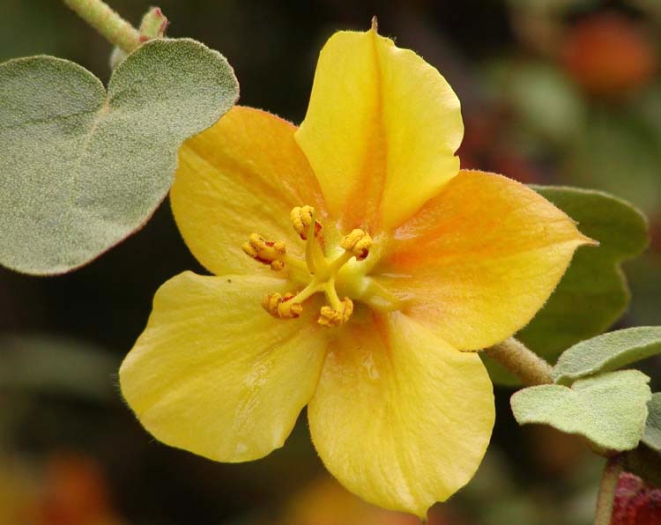Mexican Flannelbush
(Fremontodendron mexicanum)
Mexican Flannelbush (Fremontodendron mexicanum)
/
/

Stan Shebs
CC BY-SA 3.0
Image By:
Stan Shebs
Recorded By:
Copyright:
CC BY-SA 3.0
Copyright Notice:
Photo by: Stan Shebs | License Type: CC BY-SA 3.0 | License URL: https://creativecommons.org/licenses/by-sa/3.0 | Uploader: Dicklyon | Publisher: Wikimedia Commons | Title: Fremontodendron_Ken_Taylor.jpg | Notes: {{Information |Description={{en|1=Fritillaria michailovskyi}} {{ru|1=Рябчик Михайловского (Fritillaria michailovskyi)}} |Source=Own work by uploader |Author=[[User:Borealis55|Borealis55]] |Date=May 2006 |Permission= |other_versions= }} |







Estimated Native Range
Summary
Fremontodendron mexicanum, commonly known as Mexican Flannelbush, is an evergreen or semi-deciduous shrub native to chaparral and dry slopes in Southern California and Baja California, Mexico. It typically grows to a height of 6–15 feet (1.8–4.6 m) with a spread of up to 10 feet (3.0 m). This plant is characterized by its erect, multi-trunked form and leathery, olive green leaves that are furry and can reach up to 5 centimeters long, divided into several wide lobes. The showy flowers, which are actually bright orange sepals, are about 6 centimeters wide and appear along the branches without true petals, blooming from spring to early summer. The Mexican Flannelbush is notable for its vibrant, cup-shaped flowers and its adaptability to dry conditions.
Mexican Flannelbush is valued for its drought tolerance and striking floral display, making it a popular choice for native plant gardens, xeriscaping, and wildlife habitats. It is also used in natural landscaping and habitat restoration projects. While it requires good drainage, once established, it needs little to no supplemental water during the summer. It thrives in full sun and is best suited to soils with medium to fast drainage. Gardeners should be aware that it can suffer from root rot if overwatered and may be difficult to transplant due to its sensitivity to root disturbance. Despite these challenges, its low maintenance and exceptional drought resistance make it a desirable plant for dry climates.CC BY-SA 4.0
Mexican Flannelbush is valued for its drought tolerance and striking floral display, making it a popular choice for native plant gardens, xeriscaping, and wildlife habitats. It is also used in natural landscaping and habitat restoration projects. While it requires good drainage, once established, it needs little to no supplemental water during the summer. It thrives in full sun and is best suited to soils with medium to fast drainage. Gardeners should be aware that it can suffer from root rot if overwatered and may be difficult to transplant due to its sensitivity to root disturbance. Despite these challenges, its low maintenance and exceptional drought resistance make it a desirable plant for dry climates.CC BY-SA 4.0
Plant Description
- Plant Type: Shrub
- Height: 15-20 feet
- Width: 10-12 feet
- Growth Rate: Rapid
- Flower Color: Yellow, Orange
- Flowering Season: Spring
- Leaf Retention: Evergreen, Semi-Deciduous
Growth Requirements
- Sun: Full Sun
- Water: Very Low, Low
- Drainage: Medium, Fast
Common Uses
Bird Garden, Border Plant, Butterfly Garden, Drought Tolerant, Fire Resistant, Low Maintenance, Showy Flowers
Natural Habitat
Chaparral and dry slopes in Southern California and Baja California, Mexico
Other Names
Common Names: Mexican Fremontia, Southern Flannelbush, Mexikanischer Flanellstrauch
Scientific Names: , Fremontodendron mexicanum, Fremontia mexicanum, Fremontia californica var. mexicana, Fremontodendron californicum subsp. mexicanum,
GBIF Accepted Name: Fremontodendron mexicanum Davidson